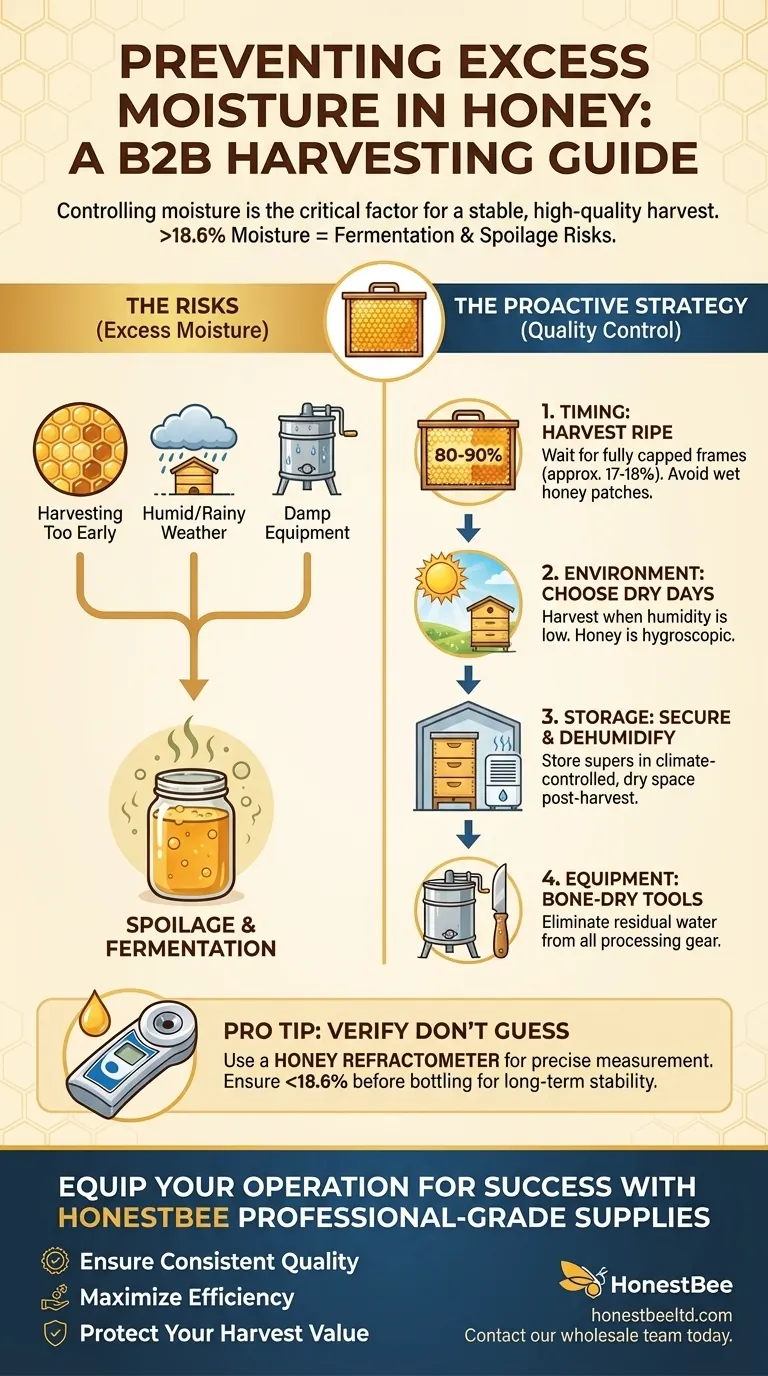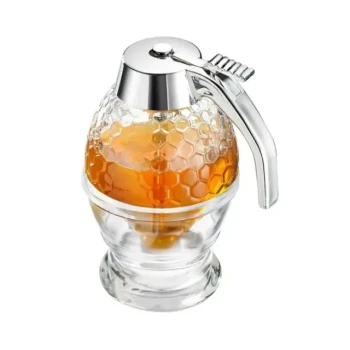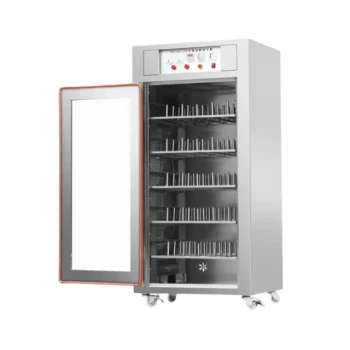Controlling honey moisture is the single most important factor in ensuring a stable, high-quality harvest. To prevent excess moisture, you must harvest only fully mature, capped honey, avoid pulling frames shortly after rain or on humid days, store your honey supers in a dry, climate-controlled space, and ensure all your extraction equipment is completely dry before use.
High moisture content is not just a minor flaw; it is the primary cause of honey fermentation and spoilage. Proactively managing moisture at every stage—from the hive to the jar—is the only way to guarantee the longevity and value of your harvest.

The Core Problem: Why Moisture Threatens Your Harvest
Understanding the science behind honey spoilage is the first step toward preventing it. Honey's natural preservative qualities are directly tied to its low water content.
The Science of Fermentation
Honey contains naturally occurring osmophilic yeasts. At moisture levels below approximately 18.6%, the high sugar concentration creates an environment where these yeasts cannot survive or reproduce.
When moisture content rises above this critical threshold, the yeasts can activate. They begin to consume the honey's sugars, producing alcohol and carbon dioxide, which results in fermentation, a sour taste, and complete spoilage.
What Causes Excess Moisture?
Excess moisture is rarely from a single mistake. It's often the result of environmental factors or process errors.
Common causes include harvesting honey too early before the bees have dehydrated it sufficiently, pulling frames during or immediately after rainy or highly humid weather, and introducing water accidentally from wet storage areas or damp extraction equipment.
A Proactive Strategy for Moisture Control
A successful strategy involves a series of deliberate checks and actions throughout the harvesting process. Each step is a critical control point.
Timing is Everything: Harvest Only Ripe Honey
The bees know best. They seal a cell with a wax capping only when the honey inside has been dehydrated to the proper moisture level (typically 17-18%). This is capped honey.
As a rule, you should only harvest frames that are at least 80-90% capped. Harvesting frames with large patches of uncapped, "wet" honey is the most common source of a high-moisture batch. Avoid harvesting frames that also contain significant amounts of brood or pollen.
Respect the Weather and Environment
Honey is hygroscopic, meaning it will actively absorb moisture from the surrounding air. Harvesting on a humid or rainy day can increase the honey's moisture content in the short time it is exposed to the air.
For best results, plan your harvest for a clear, dry day. If you live in a perpetually humid climate, your post-harvest handling becomes even more critical.
Secure Your Supers Before Extraction
Once you pull the supers from the hives, they must be stored in a dry, sealed room. A damp garage or shed can allow the honey to reabsorb moisture, undoing all the bees' hard work.
If you cannot extract immediately, storing the supers in a room with a dehumidifier for 24-48 hours is a highly effective technique for removing any incidental surface moisture before processing.
Maintain Equipment Integrity
Every piece of equipment that touches your honey—from the uncapping knife to the extractor and bottling tank—must be impeccably clean and completely dry.
Even a small amount of residual water from cleaning can contaminate a large batch of honey, raising the overall moisture content enough to risk fermentation. Always inspect your equipment thoroughly before you begin.
Understanding the Trade-offs and Common Pitfalls
Even with a perfect plan, beekeepers face real-world challenges that can compromise moisture control.
The Challenge of Humid Climates
In regions with high ambient humidity, achieving low moisture can feel like an uphill battle. The bees may struggle to dehydrate the nectar, and the risk of moisture absorption after harvesting is high. For beekeepers in these areas, a dehumidifier is not a luxury; it is essential equipment.
The Pressure to Harvest Early
There is often a temptation to pull honey early, especially if you need the space for a new nectar flow or are worried about a weak hive. Resist this urge. Harvesting uncapped honey is a gamble that almost always results in a lower-quality, unstable product.
When to Invest in a Refractometer
For serious hobbyists or commercial beekeepers, guessing is not good enough. A honey refractometer is a simple handheld tool that provides an instant, precise measurement of the honey's moisture content. It is the only way to know for sure if your honey is safe for long-term storage and allows you to make informed decisions before you extract.
Making the Right Choice for Your Harvest
Your approach to moisture management should align with your goals as a beekeeper.
- If your primary focus is maximum quality and shelf life: Invest in a refractometer and ensure every batch tests below 18.6% moisture before bottling.
- If you are a hobbyist with a small harvest: Focus on the fundamentals—harvest only frames that are over 80% capped on a dry day and ensure your equipment is bone-dry.
- If you operate in a high-humidity region: Your most critical step is climate control; use a dehumidifier in your sealed storage and extraction room before you begin processing.
By treating moisture control as a critical process from hive to jar, you safeguard the integrity and value of your entire honey harvest.
Summary Table:
| Key Strategy | Critical Action | Why It Matters |
|---|---|---|
| Harvest Timing | Harvest only frames that are 80-90% capped. | Uncapped honey has high moisture, which is the primary cause of fermentation. |
| Weather & Environment | Harvest on a clear, dry day; avoid humid/rainy conditions. | Honey is hygroscopic and will absorb moisture from humid air. |
| Storage Before Extraction | Store supers in a dry, sealed room; use a dehumidifier if needed. | Prevents honey from reabsorbing ambient moisture after removal from the hive. |
| Equipment Preparation | Ensure all extraction equipment is impeccably clean and completely dry. | Residual water from cleaning can contaminate and spoil an entire batch. |
| Verification (Pro Tip) | Use a honey refractometer to test moisture content before bottling. | Provides a precise measurement to guarantee honey is stable (below 18.6% moisture). |
Protect Your Harvest with Professional-Grade Supplies
Moisture control is non-negotiable for a high-quality, stable honey harvest. The right equipment makes all the difference. HONESTBEE supplies durable, reliable beekeeping supplies and equipment—from refractometers to extractors—designed specifically for the needs of commercial apiaries and beekeeping equipment distributors.
We help you:
- Ensure Quality: Achieve consistent, low-moisture honey batches every time.
- Maximize Efficiency: Streamline your harvesting and extraction process with robust tools.
- Protect Your Investment: Prevent spoilage and safeguard the value of your harvest.
Ready to equip your operation for success? Contact our wholesale team today to discuss your needs and discover how HONESTBEE can support your business.
Visual Guide

Related Products
- Economy Small Scale Honey Dryer Dehumidifier Thickening Machine
- High Quality Honey Dehumidifier Dryer Thickening Machine for Beekeeping
- Professional Thermostatic Conical Honey Melter
- Honey Concentrating Vacuum Heating Thickening Machine Dehumidifier for Honey
- HONESTBEE 72 Frame Industrial Electric Honey Extractor for Beekeeping
People Also Ask
- How does a honey dryer remove moisture from honey? Achieve Perfect Honey Stability with Controlled Drying
- What are some methods to prevent fermentation in high-moisture honey? Protect Your Honey's Quality and Value
- How to remove humidity from honey? Protect Your Harvest from Fermentation
- Can you dehumidify honey? A Beekeeper's Guide to Preventing Fermentation
- How to reduce moisture level in honey? Preserve Quality and Prevent Fermentation



















